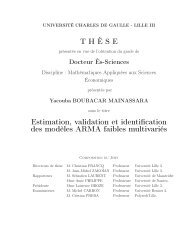A particle-in-Burgers model: theory and numerics - Laboratoire de ...
A particle-in-Burgers model: theory and numerics - Laboratoire de ...
A particle-in-Burgers model: theory and numerics - Laboratoire de ...
You also want an ePaper? Increase the reach of your titles
YUMPU automatically turns print PDFs into web optimized ePapers that Google loves.
Mo<strong>de</strong>l <strong>and</strong> motivation Auxiliary steps Results h = 0: coupl<strong>in</strong>g h = 0: <strong>de</strong>f<strong>in</strong>ition, uniqueness h = 0: <strong>numerics</strong>, existence The coupled problem<br />
Frozen <strong>particle</strong>: un<strong>de</strong>rst<strong>and</strong><strong>in</strong>g the coupl<strong>in</strong>g...<br />
The admissibility at the <strong>in</strong>terface<br />
{x = 0} of the solution<br />
is governed by the germ Gλ<br />
(term<strong>in</strong>ology related to the one<br />
of BA, Karlsen, Risebro ):<br />
Def<strong>in</strong>ition<br />
The admissibility germ Gλ ⊂ R2 (or germ, for short) associated with<br />
the <strong>particle</strong>-at-zero problem is the union Gλ = G 1 λ ∪ G 2 λ ∪ G 3 λ , where<br />
= {(a, a−λ), a ∈ R}.<br />
G 1 λ<br />
G 2 λ<br />
= [0,λ]×[−λ, 0].<br />
(0, 0)<br />
G 3 λ = {(a, b) ∈ (R+ ×R− )\G 2 λ , −λ a+b λ}.<br />
NB: the partition of Gλ <strong>in</strong>to the three parts is dictated by the<br />
subsequent analysis, <strong>and</strong> by profiles study of LST .<br />
G 2 λ<br />
−λ<br />
u+<br />
λ<br />
G 1 λ<br />
G 3 λ<br />
u−
















